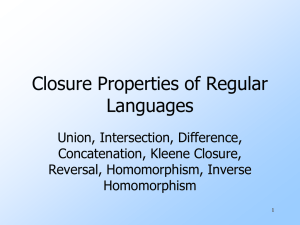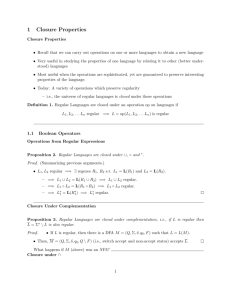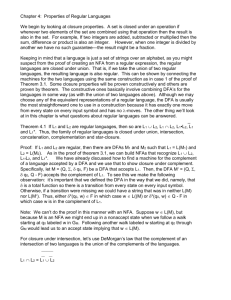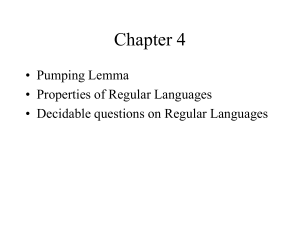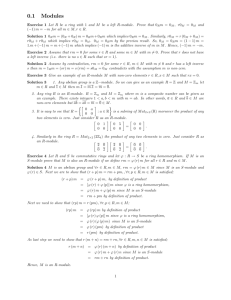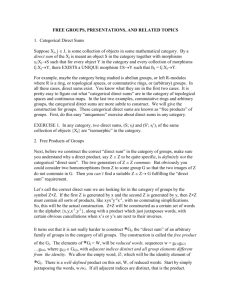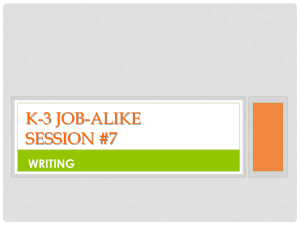PPT - The Stanford University InfoLab
advertisement
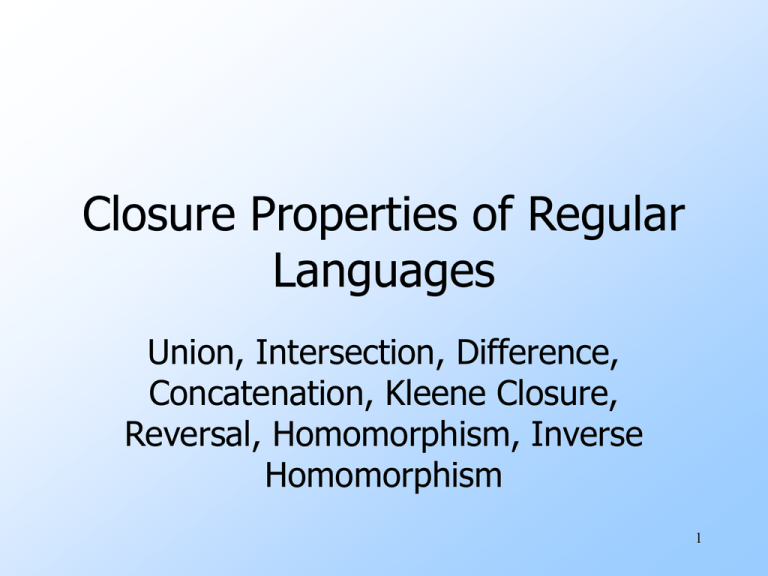
Closure Properties of Regular
Languages
Union, Intersection, Difference,
Concatenation, Kleene Closure,
Reversal, Homomorphism, Inverse
Homomorphism
1
Closure Properties
Recall a closure property is a statement
that a certain operation on languages,
when applied to languages in a class
(e.g., the regular languages), produces
a result that is also in that class.
For regular languages, we can use any
of its representations to prove a closure
property.
2
Closure Under Union
If L and M are regular languages, so is
L M.
Proof: Let L and M be the languages of
regular expressions R and S,
respectively.
Then R+S is a regular expression
whose language is L M.
3
Closure Under Concatenation
and Kleene Closure
Same idea:
RS is a regular expression whose language
is LM.
R* is a regular expression whose language
is L*.
4
Closure Under Intersection
If L and M are regular languages, then
so is L M.
Proof: Let A and B be DFA’s whose
languages are L and M, respectively.
Construct C, the product automaton of A
and B.
Make the final states of C be the pairs
consisting of final states of both A and B.
5
Example: Product DFA for
Intersection
0
0
A
1
B
[A,C]
0, 1
1
1
0
[A,D]
1
0
1
C
0
0
1
[B,C]
0
[B,D]
D
1
6
Closure Under Difference
If L and M are regular languages, then
so is L – M = strings in L but not M.
Proof: Let A and B be DFA’s whose
languages are L and M, respectively.
Construct C, the product automaton of A
and B.
Make the final states of C be the pairs
where A-state is final but B-state is not.
7
Example: Product DFA for
Difference
0
0
A
1
B
[A,C]
0, 1
1
1
0
[A,D]
1
0
1
C
0
1
0
1
[B,C]
0
[B,D]
D
Notice: difference
is the empty language
8
Closure Under Complementation
The complement of a language L (with
respect to an alphabet Σ such that Σ*
contains L) is Σ* – L.
Since Σ* is surely regular, the
complement of a regular language is
always regular.
9
Closure Under Reversal
Recall example of a DFA that accepted
the binary strings that, as integers were
divisible by 23.
We said that the language of binary
strings whose reversal was divisible by
23 was also regular, but the DFA
construction was very tricky.
Good application of reversal-closure.
10
Closure Under Reversal – (2)
Given language L, LR is the set of strings
whose reversal is in L.
Example: L = {0, 01, 100};
LR = {0, 10, 001}.
Proof: Let E be a regular expression for L.
We show how to reverse E, to provide a
regular expression ER for LR.
11
Reversal of a Regular Expression
Basis: If E is a symbol a, ε, or
ER = E.
Induction: If E is
∅,
then
F+G, then ER = FR + GR.
FG, then ER = GRFR
F*, then ER = (FR)*.
12
Example: Reversal of a RE
Let E = 01* + 10*.
ER = (01* + 10*)R = (01*)R + (10*)R
= (1*)R0R + (0*)R1R
= (1R)*0 + (0R)*1
= 1*0 + 0*1.
13
Homomorphisms
A homomorphism on an alphabet is a
function that gives a string for each
symbol in that alphabet.
Example: h(0) = ab; h(1) = ε.
Extend to strings by h(a1…an) =
h(a1)…h(an).
Example: h(01010) = ababab.
14
Closure Under Homomorphism
If L is a regular language, and h is a
homomorphism on its alphabet, then h(L)
= {h(w) | w is in L} is also a regular
language.
Proof: Let E be a regular expression for L.
Apply h to each symbol in E.
Language of resulting RE is h(L).
15
Example: Closure under
Homomorphism
Let h(0) = ab; h(1) = ε.
Let L be the language of regular
expression 01* + 10*.
Then h(L) is the language of regular
expression abε* + ε(ab)*.
Note: use parentheses
to enforce the proper
grouping.
16
Example – Continued
abε* + ε(ab)* can be simplified.
ε* = ε, so abε* = abε.
ε is the identity under concatenation.
That is, εE = Eε = E for any RE E.
Thus, abε* + ε(ab)* = abε + ε(ab)*
= ab + (ab)*.
Finally, L(ab) is contained in L((ab)*),
so a RE for h(L) is (ab)*.
17
Inverse Homomorphisms
Let h be a homomorphism and L a
language whose alphabet is the output
language of h.
h-1(L) = {w | h(w) is in L}.
18
Example: Inverse Homomorphism
Let h(0) = ab; h(1) = ε.
Let L = {abab, baba}.
h-1(L) = the language with two 0’s and
any number of 1’s = L(1*01*01*).
Notice: no string maps to
baba; any string with exactly
two 0’s maps to abab.
19
Closure Proof for Inverse
Homomorphism
Start with a DFA A for L.
Construct a DFA B for h-1(L) with:
The same set of states.
The same start state.
The same final states.
Input alphabet = the symbols to which
homomorphism h applies.
20
Proof – (2)
The transitions for B are computed by
applying h to an input symbol a and
seeing where A would go on sequence
of input symbols h(a).
Formally, δB(q, a) = δA(q, h(a)).
21
Example: Inverse Homomorphism
Construction
1
a
B
a
A
b
0
A
0
b
a
B
1
b
Since
h(1) = ε
C
h(0) = ab
h(1) = ε
Since
h(0) = ab
C
1, 0
22
Proof – (3)
Induction on |w| shows that δB(q0, w)
= δA(q0, h(w)).
Basis: w = ε.
δB(q0, ε) = q0, and δA(q0, h(ε)) =
δA(q0, ε) = q0.
23
Proof – (4)
Induction: Let w = xa; assume IH for x.
δB(q0, w) = δB(δB(q0, x), a).
= δB(δA(q0, h(x)), a) by the IH.
= δA(δA(q0, h(x)), h(a)) by definition of
the DFA B.
= δA(q0, h(x)h(a)) by definition of the
extended delta.
= δA(q0, h(w)) by def. of homomorphism.
24
